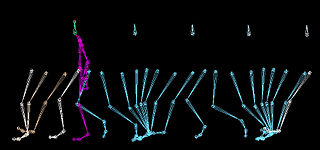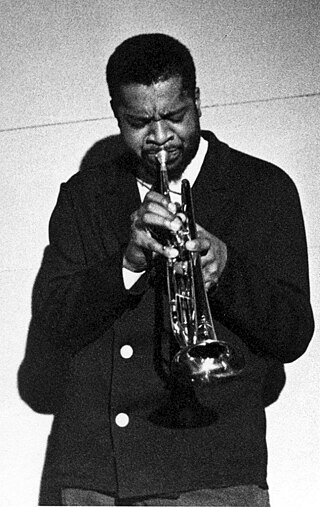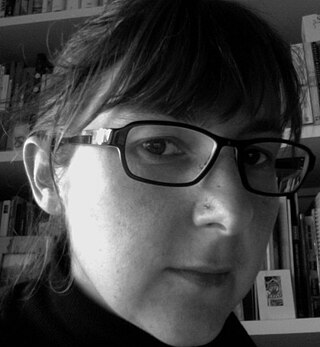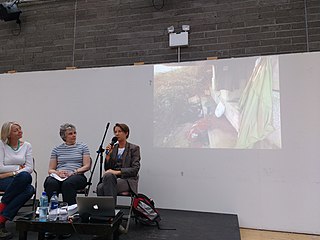Related Research Articles

Hong Kong has a highly developed transport network, encompassing both public and private transport. Based on Hong Kong Government's Travel Characteristics Survey, over 90% of daily journeys are on public transport, the highest rate in the world. However, in 2014 the Transport Advisory Committee, which advises the Government on transportation issues, issued a report on the much-worsened congestion problem in Hong Kong and pointed at the excessive growth of private cars during the past 10–15 years.

Walking is one of the main gaits of terrestrial locomotion among legged animals. Walking is typically slower than running and other gaits. Walking is defined by an "inverted pendulum" gait in which the body vaults over the stiff limb or limbs with each step. This applies regardless of the usable number of limbs—even arthropods, with six, eight, or more limbs, walk. In humans, walking has health benefits including improved mental health and reduced risk of cardiovascular disease and death.

Donaldson Toussaint L'Ouverture Byrd II was an American jazz and rhythm & blues trumpeter and vocalist. A sideman for many other jazz musicians of his generation, Byrd was one of the few hard bop musicians who successfully explored funk and soul while remaining a jazz artist. As a bandleader, Byrd was an influence on the early career of Herbie Hancock and many others.

The South West Coast Path is England's longest waymarked long-distance footpath and a National Trail. It stretches for 630 miles (1,014 km), running from Minehead in Somerset, along the coasts of Devon and Cornwall, to Poole Harbour in Dorset. Because it rises and falls with every river mouth, it is also one of the more challenging trails. The total height climbed has been calculated to be 114,931 ft (35,031 m), almost four times the height of Mount Everest. It has been voted 'Britain's Best Walking route' twice in a row by readers of The Ramblers' Walk magazine, and regularly features in lists of the world's best walks.
Central pattern generators (CPGs) are self-organizing biological neural circuits that produce rhythmic outputs in the absence of rhythmic input. They are the source of the tightly-coupled patterns of neural activity that drive rhythmic and stereotyped motor behaviors like walking, swimming, breathing, or chewing. The ability to function without input from higher brain areas still requires modulatory inputs, and their outputs are not fixed. Flexibility in response to sensory input is a fundamental quality of CPG-driven behavior. To be classified as a rhythmic generator, a CPG requires:
- "two or more processes that interact such that each process sequentially increases and decreases, and
- that, as a result of this interaction, the system repeatedly returns to its starting condition."

In urban planning, walkability is the accessibility of amenities by foot. It is based on the idea that urban spaces should be more than just transport corridors designed for maximum vehicle throughput. Instead, it should be relatively complete livable spaces that serve a variety of uses, users, and transportation modes and reduce the need for cars for travel.

Hamish Fulton is an English walking artist. Since 1972 he has only made works based on the experience of walks. He translates his walks into a variety of media, including photography, illustrations, and wall texts. His work is contained in major museums' collections, such as the Tate Britain and MoMA. Since 1994 he has been creating group walks for the public. Fulton argues that "walking is an artform in its own right" and argues for wider acknowledgement of walking art.
Karen McCoy is an American visual artist whose work focuses on sculpture, environmental art, walking art, and land art. She resides in Kansas City, Missouri, where she is a professor emeritus in sculpture and social practice at the Kansas City Art Institute. She also taught sculpture and design at Williams College (1987-1994), Colby College (1987), and the University of Minnesota-Morris (1982-1985).
Deveron Projects, formerly Deveron Arts, is a United Kingdom arts organisation based in Huntly, Aberdeenshire, Scotland that hosts international artists from a variety of disciplines to collaborate with the town community. Deveron Projects follows a '50/50' approach, which gives equal attention to impact on the local community and impact on the international art scene. Residencies have been provided to artists from China, the Americas, India, Africa and mainland Europe as well as North East Scotland.
Deirdre Heddon, is Professor of Contemporary Performance at the University of Glasgow (UK). She is a practice-based researcher and has published articles in peer-reviewed journals, as well as academic monographs and book-chapters. Her focus of interest is in autobiographical performance, site-specific performance and walking art.
Amy Sharrocks is a UK based live artist, sculptor, filmmaker and curator from London, England. Sharrocks' work focuses on collaboration and exchange, inviting people on journeys that they also help to create. She is known for large scale, live artworks in public places that use everyday activities, such as swimming or walking, in spectacular ways. Many of her artworks investigate the nature of cities, explore the importance of fluidity as a way of thinking, and question our constructs of city life. Her work has been supported by Arts Council England, The Live Art Development Agency and Artsadmin. Major works include SWIM (2007), a 50-person swim across London, and the ongoing Museum of Water (2013-Ongoing), a collection of over one thousand bottles of water from around the world.
Simone Kenyon is a performer, artist and producer born in Bradford, West Yorkshire. She works extensively with walking, and in collaboration with other artists and dancers. In 2006, with the dancer Tamara Ashley, she made 'The Pennine Way: The Legs that Make Us', a durational art project in the form of a walk, creating a performance lecture about the project for ROAM a weekend of walking at Loughborough University in 2008, and a book published by Brief Magnetics in 2007. With Andrew Brown and Katie Doubleday she instigated the 'Open City' project in 2006, exploring the organisation and control of behaviour in the public realm. Kenyon worked with Deveron Arts in Huntly, Aberdeenshire on the founding of their "Walking Institute" and completed a commission 'Hielan' Ways' - a long distance walk in the Cairngorms in 2013-14. She has also completed walking-based work Step by Step, 2013 for Dance4 in collaboration with Neil Callaghan. Kenyon is connected with the Walking Artists Network.

Clare Qualmann is a British multi-media performance artist based in London, UK. She is a senior lecturer in performing arts at the University of East London and also teaches at London Metropolitan University.
Wrights & Sites is a group of British artists who work with site-specific performance and walking art. Founded in 1997, Wrights & Sites consists of artist researchers Stephen Hodge, Simon Persighetti, Phil Smith and Cathy Turner. Their work is inspired by the Letterist and Situationist Internationals, particularly the practice of dérive.
Walkwalkwalk (2005–2010) is a British artist collective consisting of Gail Burton, Serena Korda and Clare Qualmann. Based in London, their work focused on routine walks in the Bethnal Green neighborhood of East London, as well as overlooked and forgotten spaces. Through their work they looked to create a new "'archaeology of the familiar and the forgotten' in London's East End".:50 Scholars have discussed walkwalkwalk's works in a variety of contexts, including psychogeography, walking as an artistic medium, Live Art, and criminology.
Cathy Turner is a British artist and researcher, specialising in dramaturgy, site-specific performance and walking art. She is a founder member of Wrights & Sites, and a Senior Lecturer in Drama at the University of Exeter. Turner's practice and research explore how one's life experience can influence one's perception of their environment.
Kubra Khademi is an Afghan performance artist based in Paris. She studied fine arts at Kabul University before attending Beaconhouse National University in Lahore, Pakistan on a scholarship. In Lahore she began to create public performances, a practice she continued upon her return to Kabul, where her work actively responded to a society dominated by extreme patriarchal politics. After performing her piece Armor in 2015, Khademi was forced to flee Afghanistan due to a fatwa and death threats. She is currently living and working in Paris.

Monique Besten is a walking artist, writer, performer, historian and activist. She is known for her long-distance walking work, and is the subject of articles and publications discussing the use of walking as an art practice; she is a member of the Walking Artists Network. She has been cited by scholar Phil Smith as part of a new generation of artists engaging site-specific theatre through 'performative journeys'.
The Loiterers Resistance Movement (2006–present) is a 'Manchester-based collective of artists and activists interested in psychogeography and public space.' The Loiterers Resistance Movement (LRM) are core contributors to what Tina Richardson has identified as the 'new psychogeography', and a variety of scholars have cited the LRM as key to the development of contemporary British psychogeography.
Walking art refers to a variety of artistic practices that position walking as the central process, experience or outcome. Walking artists have diverse interests and it 'has gathered practitioners from nearly every field'.:43 Despite emerging from a variety of artistic and literary traditions, a 'common feature [of walking art] is the engagement of the body in a process of walking through a landscape based on a specific artistic design.':161 Some artists consider walking an artistic end in itself, while others use walking as a means of mark-making, storytelling, social practice, or to create work in other artistic media.
References
- ↑ Heddon, Deirdre; Turner, Cathy (1 May 2012). "Walking Women: Shifting the Tales and Scales of Mobility" (PDF). Contemporary Theatre Review. 22 (2): 224–236. doi:10.1080/10486801.2012.666741. ISSN 1048-6801. S2CID 143812276.
- 1 2 3 4 5 6 Morris, Blake (15 November 2019). Walking Networks: The Development of an Artistic Medium. Rowman & Littlefield International. ISBN 978-1-78661-022-5.
- ↑ Owen, Louise (1 November 2013). "Robert Wilson, Walking (Holkham Estate, 2012)". Contemporary Theatre Review. 23 (4): 568–573. doi:10.1080/10486801.2013.839177. ISSN 1048-6801. S2CID 143698890.
- ↑ Doonan, Natalie (25 March 2015). "Techniques of Making Public: The Sensorium Through Eating and Walking". Theatre Research in Canada / Recherches théâtrales au Canada. 36 (1): 52–72. doi:10.3138/tric.36.1.52. ISSN 1913-9101.
- 1 2 O'Neill, Maggie; Roberts, Brian (9 July 2019). Walking Methods: Research on the Move. Routledge. ISBN 978-1-317-29502-0.
- ↑ "Walking Artists' Network". www.walkingartistsnetwork.org. Retrieved 5 July 2016.
- ↑ "JISCMail - WAN List at WWW.JISCMAIL.AC.UK". www.jiscmail.ac.uk. Retrieved 26 April 2021.
- ↑ "History". 23 March 2011. Retrieved 23 July 2016.
- ↑ Research Council UK. "Footwork - The Walking Artists Network as Mobile Community". gtr.rcuk.ac.uk. Retrieved 5 July 2016.
- ↑ "Step by Step Seminar series". Walking Artists Network. 17 July 2015. Retrieved 26 April 2021.
- ↑ "AIRSPACE". www.airspacegallery.org. Retrieved 26 April 2021.
- ↑ Bonnett, Alastair (1 September 2017). "The enchanted path: magic and modernism in psychogeographical walking". Transactions of the Institute of British Geographers. 42 (3): 472–484. doi:10.1111/tran.12177. ISSN 0020-2754.
- ↑ Qualman, Claire Hind Clare (24 July 2015). Ways to Wander. Triarchy Press. ISBN 978-1-909470-73-6.
- ↑ "WALKING WOMEN - Events". Live Art Development Agency. Retrieved 2 February 2019.
- ↑ FM, Resonance. "Clear Spot - 14th July 2016 ('Er Outdoors #3)". Mixcloud. Retrieved 2 February 2019.